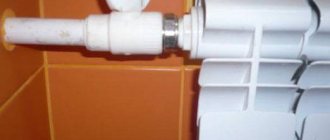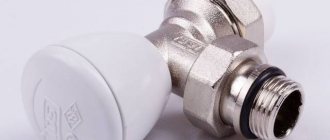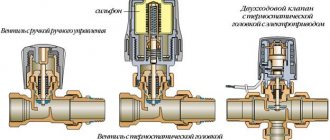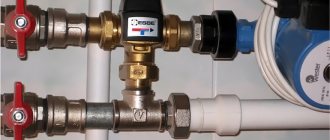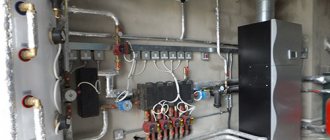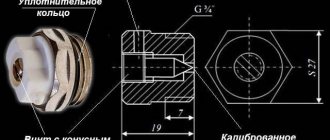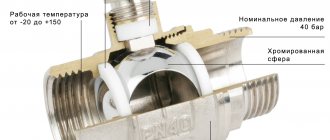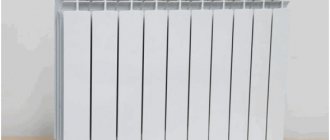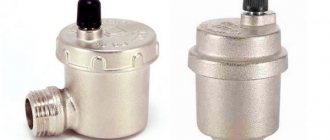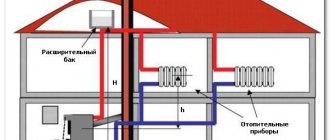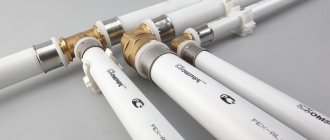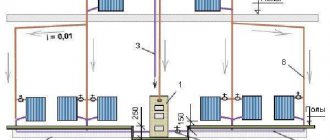What is it and what is it for?
A three-way valve is a “tee” with a locking mechanism. His task:
- Mix flows of different media transported through a pipeline - coolant in a heating circuit, water in a hot water supply system, gases or other substances in industrial lines, etc. To simplify, such three-way taps can be compared to typical kitchen faucets, with the only difference being that they remove the mixed medium not into the usual sink, but into one of the main branches.
- Divide the flow of the transported medium and divert it along different circuits.
Hence the fundamental division of three-way valves into mixing and separating.
Purpose and scope of three-way valves
The main task of a three-way valve is mixing or separating main flows. But where might these functions be needed and, most importantly, why?
- The thermostatic mixer is an important part of a modern and, most importantly, energy-efficient heating system. Its installation on the supply circuit and simultaneous connection to the return circuit allows you to regulate the degree of heating of the coolant. This prevents the batteries from overheating, ensuring a comfortable room temperature. That is, the “tee” is a kind of thermal power regulator.
- Three-way taps are indispensable in underfloor heating systems, where the heating temperature of the coolant is strictly regulated. In addition, they are used in complex heating circuits, where their installation makes it possible to stabilize the heating temperature in all radiators in the network.
- Also, “tees” are installed in hot water supply systems equipped with a boiler.
- Three-way valves are a mandatory safety element for gas pipelines and fountain systems, equipped with a pressure gauge, in front of which they are, in fact, installed.
Three-way mixers are widely used in the industrial and agricultural sectors. They are used to equip a variety of equipment, from the familiar washing machines and cars to complex engineering systems in ships and locomotives.
Three-way taps are also used in medicine. They are used to equip infusion lines - a necessary part of complex medical equipment.
Technical and operational characteristics of three-way valves
Key technical parameters of three-way valves:
- The standard size, or more precisely, the nominal diameter of the pipes.
- Throughput directly related to the cross-sectional size of the pipes.
- Operating pressure.
- Maximum permissible temperature.
- Tightness class.
- Service life, which determines the estimated number of revolutions (cycles).
- Type of main connection - threaded, flanged, union-end, coupling, pin or welded.
All these characteristics for shut-off valves are strictly regulated by GOST standards. The difference between them depends on the model of the product and the materials from which it is made.
How many positions does a three-way valve have?
The number of operating positions of three-way valves is determined by the shape of the channel in the valve and its purpose. The diagram is shown in the photo below:
- Three-way T-shaped mixers have 4 operating positions.
- Three-way L-shaped valves with a rotation angle of 90 or 180° have only 2 operating positions.
- “Tees” working in tandem with a pressure gauge, regardless of the shape of the channel in the valve, operate in 4 positions. The fifth is considered a neutral (non-working) mode.
On a note! Three-way valves are not designed to completely shut off flow in all directions. They only redirect the transported medium from one branch to another or mix them, temporarily blocking one of the pipes.
What materials are three-way valves made of?
The strength of shut-off valves and its operational capabilities are determined by the material from which it is made.
For the body, stem and shut-off element of three-way valves, the following is most often used:
- Plumbing brass. The excellent characteristics and relatively light weight of such models explain why they are most often found in domestic heating and water supply systems. For additional protection, parts can be plated with nickel or chrome.
- Bronze. Bronze products are also of excellent quality, but due to their cost they are less in demand.
- Carbon steel. In fact, it is a cheaper analogue of brass. However, the choice of shut-off valves made of carbon steel should be approached responsibly, because low-quality alloys significantly reduce the service life of the locking mechanism.
- Cast iron. Such “tees” are used only in utility systems and on industrial highways. Having good anti-corrosion properties, cast iron products wear out extremely quickly, and their high weight significantly reduces demand.
In the agro-industrial complex and in medicine, three-way valves made of polymers are often used.
The locking element of some models can be made of ceramic. It is reliable and wear-resistant. However, ceramics are extremely sensitive to the composition of the transported medium. If the media is not clean enough, such a mechanism will very quickly fail. Therefore, three-way valves with a ceramic cartridge are most often installed in water supply systems or heating circuits running on purified antifreeze.
The sealing parts of the “tee” (gaskets, oil seal, seat rings) can be made of Teflon. Its use increases the operating temperature of a three-way mixer to 150 °C. The rings can also be coated with fluoroplastic.
Areas of application
Modern valves are in wide demand and are actively used in various areas of human activity. They are often installed in modern heating mains, which require constant adjustment of proportions when mixing different coolant flows. For such purposes, it is customary to use electromagnetic devices or models with a thermal head.
As for domestic use, in this case it is enough to purchase a thermostatic mixing device that will allow you to regulate the temperature of the coolant. It is supplied both to the underfloor heating piping system and to heating radiators. And if the household device is equipped with automatic control, then changing the temperature in the room will be much easier.
The use of a three-way valve in a heating system is profitable and economical
It should be noted that using a tee in a heating system to balance possible temperature surges is not only beneficial, but also economical. The device allows you to reduce the volume of fuel consumed several times, while the final efficiency indicators of the system will increase noticeably. In some rooms, the presence of such a device is simply necessary. For example, if a heated floor is installed in the house, then the device will prevent excessive heating of the floor covering.
Design and principle of operation of a three-way valve
The design of a three-way mixer includes the following elements:
- Sealed housing with three T-shaped pipes.
- Valve with internal T- or L-shaped channels. Most often, the bolt mechanism has the shape of a ball, less often a cone or cylinder.
- Stuffing box.
- A rod that transmits movement to the bolt mechanism.
- Control unit - handle (butterfly or lever) or drive.
The operating principle of a three-way valve is based on the rotation of the valve inside the body. An L- or T-shaped stroke drilled into the valve serves to pass flows. By turning, the shutter either opens all the holes in the pipes or closes one of them.
Let's consider the principle of its operation using the example of a heating circuit. A three-way valve is installed in the circuit so that one of its pipes is connected to the pipeline coming from the boiler.
The pipe located in the middle is connected through a bypass connection to the “return”, where the coolant has a lower temperature. The third pipe connects to the pipeline going to the radiators.
On a note! The installation diagram is indicated by the manufacturer in the form of markings on the “tee” itself.
The shutter position is set by turning the handle:
- In the first position, transported flows are mixed, simultaneously coming from the circuit supplied from the heat generator and from the “return” circuit.
- In the second position, only hot coolant from the boiler is supplied to the heating circuit.
- In the third position, the flow of hot coolant is blocked, only cooled water from the return circuit is supplied to the system.
general information
Three way valve parts
- Metal body
- Gate with passage channels
- Three pipes. Two for cold and hot water, the third for the outlet of heated heating fluid.
How does a three-way valve work in a heating system?
Pipes with liquids from the heating boiler and return are connected to the three-way mixer. The angle of rotation of the lever or valve on the control valve determines what temperature the liquid will flow through it.
- The shutter is open - the degree of heating of the coolant is identical to the heating level in the boiler
- The tap is turned off - the return water (cooled) goes to the batteries
Any other position of the tap allows the water to mix. Thus, the temperature of the liquid in the heating line is controlled.
Types of distribution taps
Plumbing retail outlets have a huge selection of fittings of this type in different models. To select the required model of a three-way heating tap, you need to know: the features of the product, its design, and see the differences between devices.
Product models without external differences, all have three pipes, but the functions they perform are fundamentally different
- Mixing tap (adjusting). Allows you to mix liquid from two pipes. The connection is made to two pipes, and the output is made one at a time. The product is equipped with a valve stem
- Distribution valve (shut-off valve). Divides fluid from one line into two streams. Valves are mounted in pipes. When one valve opens, the second one closes. The liquid enters the tap through one line, and exits through two. Products of this type are installed to maintain optimal temperature conditions in several rooms.
Product body
Brass is a durable alloy, resistant to mechanical damage, without temperature restrictions. Service life up to 50 years.- Steel – increased strength (lower than brass alloy), long service life
- Cast iron - installed in industrial systems, on pipes with a diameter of 4 cm.
Installation methods
- Coupling connection
- Using flanges
- Welding method
Gate
- Tensioner
- Omental.
Product type
- Ball
- Conical
- Cylindrical
Control
Household three-way taps for heating systems are equipped with different controls.
- Mechanical control. The faucet is equipped with rotary levers that regulate the flow of liquid. Changing the position of the handle creates a difference in the volume of liquid coming from different sources. The disadvantage of a mechanical product is the long and uneven heating of the system.
- Automatic control. The automatic product maintains the set temperature without human influence. Installing an automatic tap guarantees high-quality and uniform heating. A functioning system does not require constant monitoring.
The three-way valve is equipped with types of control such as servo-driven, hydrodynamic or pneumatic thermostats.
Tee for heating with electric drive
The servo drive control element is an electric motor. The control unit signals the servo drive that the specified parameter has been exceeded, and the motor changes the position of the ball or rod. The electrical unit measures the degree of heating of the medium at the outlet of the regulator or by heating the return and liquid from the boiler and optimizes the setting.
Three-way valve for heating with thermostat
The thermal head of the distributor contains gas or a special liquid, they respond to increases and decreases in temperature in the external environment, their volume changes, and the valve responds to changes automatically.
When installing the product, its conscientious and attentive adjustment is necessary. The maximum and minimum permissible temperatures are set at the final positions of the lever. This creates a range of operation within which a model with a thermal regulator for the heating main adjusts the heating of the liquid in the system. To achieve this, a mechanical correction of the pressure in the valve is performed.
The liquid will flow through the tee as many times as necessary to reach the specified temperature. If the temperature indicator crosses the established limits, the water mixing ratio (DHW and cold water) in the device will change.
The main advantage of the model with thermal regulation is that it does not require a control unit for its operation. The crane performs its functions autonomously and has a reasonable price.
Pros and cons of three-way valves
| Advantages | Flaws |
| Compact and ergonomic | Limited functionality |
| Convenient controls. Soft smooth shutter movement when switching modes | |
| Possibility of use in polluted environments. An exception is three-way mixers with a ceramic shutter | Not intended for adjusting flow intensity and installing the shutter in intermediate positions |
| When installed in a heating circuit, they act as a thermostatic device, which allows optimizing the energy efficiency of the system | |
| High seal tightness | |
| Low level of hydraulic resistance | Rapid wear and frequent jamming when operating in adjustment mode |
| The “tee” design prevents accumulation and stagnation of the transported medium | |
| Simple, clear design and operating principle | |
| Ease of installation | Limited temperature: maximum 200 °C |
| Ease of use. Reduced requirements for regularity of performance checks | |
| Long service life |
The difference between a three-way tap and a gate valve, valve and valve
The faucet, gate valve, valve and thermal valve belong to the class of shut-off and control valves. However, the shape of the bolt mechanism and the principle of operation are different. For greater clarity, I have summarized the comparative characteristics of the devices in a table:
| Tap | Valve | Gate valve | Valve | |
| Shutter function | + | + | + | + |
| Adjustment function | Not recommended | + | + | + |
| Gate shape | Ball, plug | Wedge | Disc, wedge | Books |
| The principle of movement of the bolt mechanism | Around its own axis | Parallel to the flow | Perpendicular to flow | Parallel to the flow |
| Control handle | Lever arm | Flywheel | Flywheel | Lever, flywheel |
| Possibility of installing an electric drive | + | + | + | + |
| Possibility of installing a thermostat | External only (for automatic models) | + | — | + |
| Compactness | + | — | — | + |
From the table data it is clear that the tap is less functional. However, this is precisely why it is more reliable and lasts much longer than its counterparts.
Design and principle of operation of a three-way valve in a heating system
To make it easier for you to understand the principle of operation, I suggest considering this diagram:
Sectional design of a three-way valve.
When it is necessary to achieve a certain temperature, the rod rises, opening the duct. This is reminiscent of the operating principle of shut-off valves. And the mechanism itself is called a saddle mechanism. Instead of a rod, a ball or a rotating sector is sometimes used. Exactly the same as in conventional ball valves. This mechanism is called a rotary mechanism. They can be depicted in the diagram as follows:
I’ll talk about what exactly controls the rod or ball a little later. For now, let's look at each type. Let's start with the mixing valves:
As you can see, hot water enters from the left and cold water from below. The rod rises when necessary, allowing the two streams to be mixed.
And this is what the operation of a separating valve looks like. Here, on the contrary, hot water enters from the right, and can exit to the left or down. If the temperature is normal, the rod rises. If higher temperatures are required, the rod is lowered, sending hot water downwards. That is, in the opposite direction.
From the instructions for the VMR type valve from Mut International.
Typically, thermomixing and separation valves do not close completely. But the switches, as you can see, close one of the pipes and open the other. In this case, no mixing or separation occurs.
Cross-section of a typical three-way valve.
Types of three-way valves
Design features suggest dividing three-way mixers into several types:
| Options | Types of three-way valves |
| Bolt mechanism type | Ball, cork (cylindrical, conical) |
| Gate bore diameter | Full bore, reduced (the diameter of the channel in the shutter mechanism is somewhat narrowed) |
| Shape of the channel in the bolt mechanism | T-shaped, L-shaped |
| Control method | Manual (lever, butterfly), with electric drive, with pneumatic drive |
| Connection method | Threaded (coupling, fitting, pin), welded, flanged |
Using the drive in combination with a remote temperature sensor, controller or manual switch allows you to automate the control process. Pneumatically driven models are safer than their electric servo-driven counterparts.
Service life of three way valve
The period of trouble-free operation of the device is determined by:
- Design features.
- The material from which it is made.
- Compliance of its technical characteristics with real operating conditions.
Manufacturers give a guarantee of 5-7 years for steel “tees”, but with moderate intensity they can easily last 50 years. The service life of plastic models, as a rule, does not exceed 2 years.
How to choose a three-way valve
Before purchasing a three-way mixer, you need to resolve the following issues:
- Scope of use.
- Maximum heating temperature of the transported medium.
- The diameter of the pipe to which the “tee” will be connected. If a suitable size is not available, an adapter is installed first.
- System operating pressure.
- Control method. For “warm floors” it is better to take models with a drive.
The main technical characteristics of a three-way valve can be seen on the body.
Popular manufacturers of three-way valves
The modern range of shut-off valves can confuse the average person. But not all meet quality standards. Among those who have long established themselves in the plumbing market, I would highlight:
- German brand Danfoss.
- Swedish manufacturer ESBE.
- Austrian company HERZ.
- Russian-Italian brand Valtec.
Approximate prices for three-way valves
The cost of shut-off and control valves depends on:
- Dimensions
- The material from which it is made.
- Technical parameters.
Manually controlled devices are 2-3 times cheaper than electric and pneumatic ones.
Rules for installing a three-way valve
- The installation site must be freely accessible.
- The “tee” is installed with the lever up or sideways (outward). The control lever should move freely in the desired direction.
- Markings in the form of arrows on the device body will tell you how to correctly connect it to the system. The arrows indicate in which direction the flow will move.
- If the quality of the coolant is low, it is advisable to install a filter in front of the three-way mixer.
- In the heating circuit, a “tee” is installed in front of the circulation pump.
- The threaded connection must be sealed with flax fiber and treated with a sealant.
- When connecting for welding, it is necessary to avoid the formation of scale inside the line.
Connection diagram of a three-way valve to the heating circuit
Connection diagram of a three-way faucet to a water supply system with a water heater
Types of taps for pressure gauges
The devices differ in design features and mounting methods.
Cork tensioners
The material for the manufacture of this type of tap is brass, which makes these devices not strong enough; when tightening the nut, the plug at the end may break, and the locking mechanism requires some effort to start.
This type of device has 4 varieties:
- Design with threads on both sides, can be either metric or pipe thread.
- A device in which there is a pipe thread on one side and a metric thread on the other.
Note! The third hole of the tap in both cases is defined as drainage.
- A more advanced design, equipped with a lever-type or butterfly-type shutter.
- The device also has threaded holes on both sides and additionally a flange for connecting a measuring device.
Ball with drainage
The most modern and popular device, because it is much more convenient to use: it is a lightweight design equipped with a handle. The valve is characterized by high levels of tightness and the impossibility of accumulation of contaminants in the flow part.
Ball with coupling
Made from chrome plated brass. The pressure gauge or drain in this case is connected to the coupling, so this valve is not a three-way valve in the literal sense.
We recommend that you read: Features and purpose of cast iron valves
Button
It differs from all other types of taps in the presence of a button; with its help, measurements are taken as long as the button is pressed; when released, the pressure gauge automatically turns off.
Rules for operating a three-way valve
The “tee” installed in the system requires periodic inspection for wear and leaks. If a leak is detected, you can try tightening the threaded connection. If the leak cannot be eliminated, the mixer will have to be disassembled. Very often it is the O-rings that wear out. Replacing them and cleaning the elements from scale extends the life of the device.
To reduce the wear of the device, it must be periodically lubricated with a special plumbing product.
Common mistakes and problems when installing a three-way valve
Errors made when installing a “tee” not only shorten its service life, but also negatively affect the operation of the entire pipeline:
- Incorrect connection of pipes increases hydraulic resistance.
- The use of models with fluoroplastic seals in systems with operating temperatures above 150 °C will require replacing the three-way mixer after 2-3 months.
- Installation in a hard-to-reach location will complicate preventive maintenance procedures.
Expert advice
- During installation, the brass body is easily damaged. To prevent this, it is better to place a thick fabric gasket under the wrench.
- To install a three-way valve on plastic pipes, special adapters are needed.
- Instead of a “tee”, you can use 2 conventional two-way valves. They must work according to a reverse pattern: when one opens, the other closes.
Use in heating systems
You can very easily obtain the required temperature of the water flow at the outlet of the three-way valve. You just need to correctly determine the proportions of hot and cold liquid in order to create an acceptable temperature regime. If the device is correctly installed in the heating system, and adjustments have been made, then it will be able to perform its direct functions of separating or mixing flows.
A faucet that is installed to have 2 outlets will only have one inlet. These devices are often used to separate hot water into two different streams. They are often used in water heater systems.
A three-way device can operate from a manual or electric drive, but in practice manual control is often used. This product is very similar to a standard ball valve. Electric taps are usually used to regulate heat transfer from radiators in the heating system of private houses. They are also built in during the installation of heated floors.
